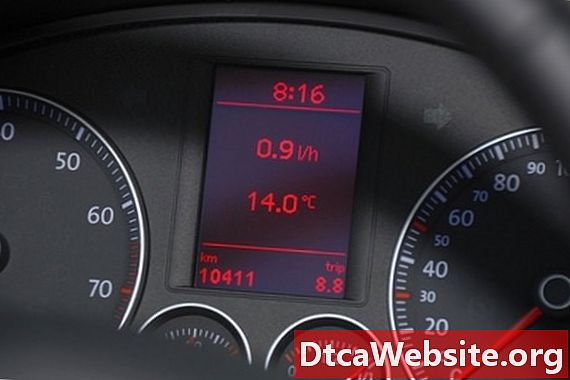
Contenu
- Checking the Sensors Visually
- Step 1
- Step 2
- Step 3
- Step 4
- Removing the Tire Pressure Sensors
- Step 1
- Step 2
- Step 3
- Step 4
- Tip
- Warning
- Items you will need

Tire pressure sensors work with the tire pressure monitoring system on many passenger vehicles. These sensors show the driver the PSI (pounds per square inch) of pressure in each tire by displaying the readings on the vehicles instrument panel. There are a couple of ways to check the system. First, the system can be checked digitally by looking at the reading on the electronic display. Second, the system can be checked by removing the tire and checking the electronic valve stem.
Checking the Sensors Visually
Step 1
Turn on the vehicle by turning the key in the ignition. This will allow the tire pressure monitoring system to start and immediately read each tires pressure.
Step 2
Select the option to see the tire pressure sensors on the dashboard. If the PSI numbers match the correct amount of PSI in each tire, the sensors are properly working. If the tire pressure monitoring system warning light is on, the tires must be checked.
Step 3
Remove the tire valve caps of each tire by twisting them counterclockwise. Check each tire manually using the tire gauge. A tires PSI should be inflated to the correct amount, which is stated on the side of the tire or in the vehicle owners manual.
Step 4
Fill each tire with the appropriate amount of air with the air compressor. Periodically check the PSI using the tire gauge. Screw on each valve cap.
Drive the car around the block. This will allow the tire pressure monitoring system to recalculate. The system should display the correct amount of air in each tire.
Removing the Tire Pressure Sensors
Step 1
Place the lug nut wrench on each lug nut of the wheel being removed. Press the lug nut wrench downward using your foot to loosen each lug nut from the wheel. Do not remove the lug nuts from the wheel until the car is jacked up. Do this before jacking the car up to keep the wheel from spinning while suspended in the air.
Step 2
Place the jack under the vehicles chassis, closest to the wheel being removed. Jack the car up enough to remove the wheel. Unscrew the lug nuts by hand and place them to the side for future use. Remove the wheel from the vehicle. Roll the wheel to a workbench or area where the tire can be removed.
Step 3
Remove the tire stem valve cap by twisting it counterclockwise. Press the center of the valve stem down to deflate the tire. Unscrew the bolt with the pliers if there is one holding the tire pressure sensor in place. This bolt must be removed to pull the valve out from inside of the tire to prevent damaging the system.
Step 4
Remove the tire from the rim using the crowbar. Bring the wheel to an auto mechanic if the tire cannot be removed easily.
Pull out the tire pressure sensor from the inside of the tire. Check the sensor to see if it is cracked or damaged. Replace the sensor if it damaged. Tire pressure sensors can be purchased at the vehicles dealership or at an automotive parts retailer.
Tip
- Check the tires manually during cold weather. Tire pressure sensors sometimes do not work properly in cold weather.
Warning
- Jack the vehicle up on a level surface to prevent the jack from sliding out from under the vehicle.
Items you will need
- Tire gauge
- Air compressor
- Lug nut wrench
- Car jack
- Pliers
- Crowbar


